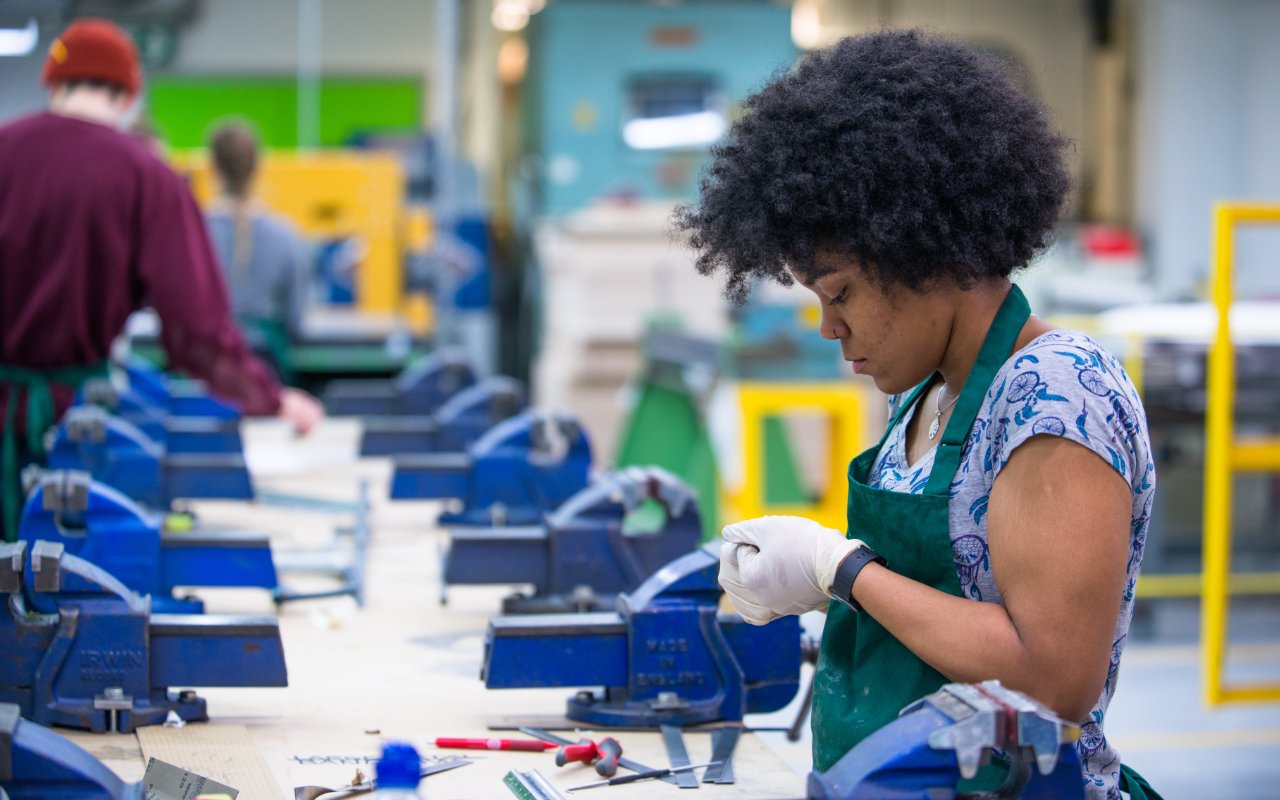
Skills developed in creative degrees have been found to boost employment opportunities
Photo: Paul Carter
Skills for innovation
Creative skills don’t just benefit the creative industries; they bring huge value to other sectors including business, health and engineering. Professor Steven Spier has the evidence.
As someone who has worked in the creative industries and who has been involved with the provision of creative education internationally, I am personally aware of the skills that are developed in creative degrees and their value to society and the economy. As Vice-Chancellor of Kingston University, I have become increasingly concerned at the disconnection between the proven importance of the creative sector to the future growth of the economy, and the current drift of education policy.
The Office for Students, for example, recently set out that art and design are not among the Government’s strategic priorities and that their funding will be cut relative to STEM subjects. We’re expecting to see other policy and funding challenges to creative education in the upcoming comprehensive spending review.
As a university with a leading art and design school, I have seen the added value it and its pedagogy brings to other subject areas, such as business, health and engineering. To explore the value of creative skills further, we set about asking a wide range of employers, such as Lidl, Mastercard, Ocado and Deloitte, about the challenges they face in maintaining their global, competitive edge and the kinds of skills they will need from their future workforce to deal with the challenges of a post-Covid, post-Brexit environment.
Competition from emerging economies
To provide an evidence base about business needs, we took these findings and put them to over 2,000 employers across the UK – from micro-businesses to multinationals, from hospitality to manufacturing – with a poll through YouGov Business. Strikingly, more than half (56%) of business decision makers were concerned about the competition from emerging economies such as China and Singapore.
This should give policymakers who are downgrading the importance of creative subjects reason to pause: these countries are investing heavily in creative education and design skills. In December 2020, Singapore’s Ministry of Trade and Industry partnered with DesignSingapore Council to launch the Design Education Advisory Committee (DEAC).
The Minister of State for Trade and Industry, Low Yen Ling, said “… the DEAC will play a vital role in ensuring an agile workforce equipped with the ability to understand changing user behaviour, and capable of innovating and solving complex problems. These valuable skillsets are key in enabling businesses to become more resilient and competitive, especially amid the current global uncertainty”.
What skills do businesses need?
While much of the political discussion around a skills shortage focusses on short-term need, we were interested in what businesses needed for the next 10 to 20 years; the skills that will help them meet the challenges they had identified. The business decision makers listed a set of skills that correlate closely with the competencies taught on creative degrees, and that I have named Skills for Innovation. Nine of the 10 skills they identified correlate with those of designers.
The top 10 skills identified were:
| Problem solving | 77% |
| Communication | 66% |
| Critical thinking | 64% |
| Digital skills | 64% |
| Analytical skills | 63% |
| Initiative | 62% |
| Adaptability | 60% |
| Creativity | 56% |
| Relationship building | 55% |
| Questioning mindset | 55% |
The Future Skills report, which includes this skills league table, cites a number of examples of how creative skills applied beyond the creative industries have led to business transformation, regional growth, and impact on local communities. We know that the UK is pre-eminent in the creative industries but it also acts as a catalyst in others, such as healthcare, local services, sustainability and regeneration. This is the environment in which the rigour of creative problem solving helps grow new approaches, products, and industries, and why art and design schools give universities an edge.
Multidisciplinary collaborations in practice
As an example, at Teesside University, TUCAN Studio brings multidisciplinary teams of graduates, academic staff, leading researchers and students together to collaborate on creative digital solutions, driving innovation. In partnership with Cleveland Fire Brigade, for instance, TUCAN developed a bespoke virtual reality training module for fire commanders to enhance their life saving skills in the field.
In another example, Deloitte Digital brought creatives into the core of their management consultancy business to help their clients innovate successfully. The creative team at Deloitte Digital has grown 20% per annum, now numbering around 250 people, and has contributed to a tenfold growth at the company.
In a third example, design graduates from the Kingston School of Art started their own firm that has developed bioplastics from food waste for use in fashion and interior design, and who employ a biochemist, polymer chemist, and a chemical engineer.
To build on the findings of the report, we are calling on the Government to invest in the skills for innovation the UK needs to ensure its future competitive advantage, and particularly for the Department for Education (working with its equivalents in the devolved nations) to develop a Creative and Innovation Skills Strategy that identifies and promotes strategically important creative subjects and skills that businesses want.
Professor Steven Spier is Vice-Chancellor of Kingston University and a Director for the University Alliance on Creative Industries.
Join the Discussion
You must be logged in to post a comment.